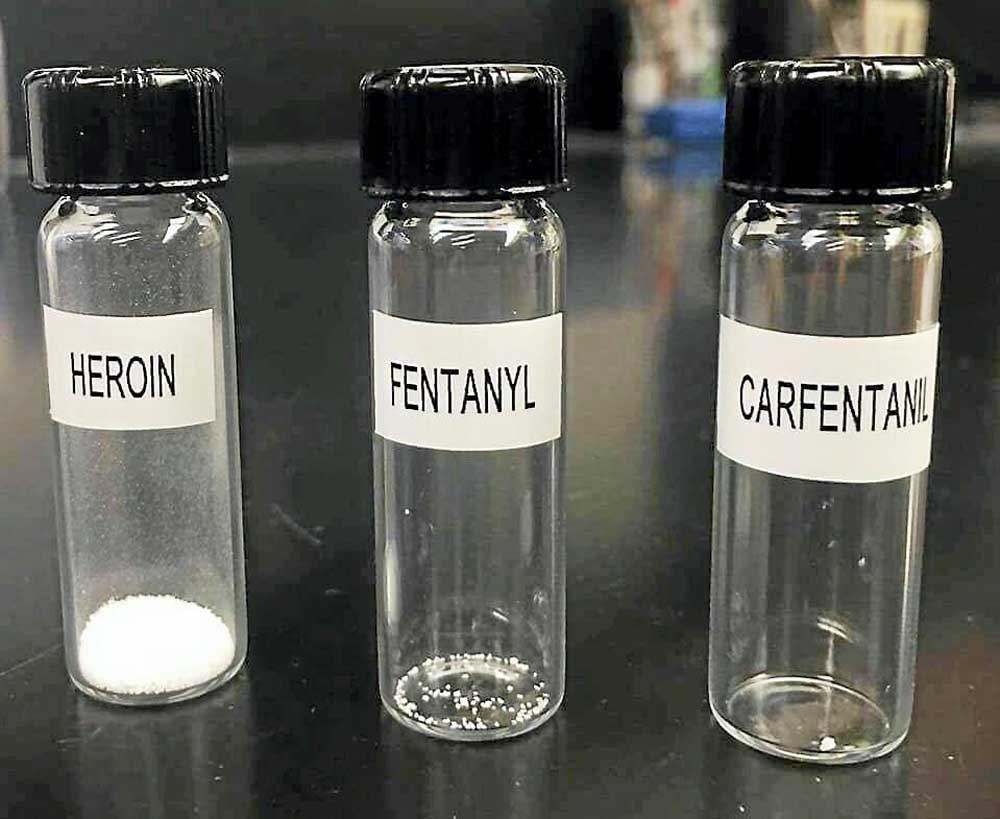Carfentanil, more powerful than fentanyl, resurfaces nationally, in Oregon
Published 2:00 pm Wednesday, November 22, 2023

- Three vials showing a lethal dose of heroin, fentanyl and carfentanil, illustrating the differences in potency.
A national drug testing laboratory said it has seen the reemergence of carfentanil, an ultrapotent synthetic opioid, though the total number of positive tests remains low.
One positive urine test result — the only one in Oregon — came from Oasis Center of the Rogue Valley in Medford.
Trending
Dr. Eric Dawson, vice president of clinical affairs at the San Diego-based Millennium Health, said the use of carfentanil peaked in about 2016-17 and had largely dropped off until the middle of this year.
In 2022, the lab saw one positive result, in Pennsylvania.
As of early this month, Millennium Health had seen at least 35 positive results across a dozen states for 2023. In addition to the Medford result, the lab saw four in Washington state, two in California, seven in Minnesota, five in Ohio, one in Indiana, one in Kentucky, four in Louisiana, one in Maryland, four in Virginia, three in Florida and two in Alaska.
Most of these results have surfaced since summer began, prompting Millennium Health to issue an alert.
“You don’t want to be accused of being an alarmist,” Dawson said. However, “at the same time, considering the fact that we saw one carfentanil positive in our database last year, in all of the year, and we’ve seen 35 over mostly this summer and September, that is obviously a dramatic increase.”
Carfentanil, a fentanyl analogue — meaning the substances have a similar chemical structure — is used to tranquilize large animals like elephants and rhinoceroses and is not approved for human use.
Trending
“To think that a drug that is used for that purpose is in our communities to any extent is alarming,” Dawson said.
The federal Centers for Disease Control and Prevention says carfentanil is about 100 times more powerful than fentanyl, which is itself up to 100 times more powerful than morphine.
In roughly 2016, carfentanil rode in on the larger fentanyl wave that began a few years earlier. From the epicenter of Ohio and Kentucky, the drug spread to Michigan, Pennsylvania and Florida.
“There were so many deaths in those five states it pushed the national overdose numbers to a new trajectory,” Dawson said. “I mean, it changed the trajectory of the total overdose curve, if you will.
“And then from those five states, it did spread elsewhere. But I think largely the bulk of the consequence of carfentanil’s presence remained in those five states.”
This time, the drug does not seem to have cropped up in any one region and spread from there.
“If this does indeed become something, it seems that the outset is already different — that it’s much more widely dispersed than what we saw in 2016, 2017,” Dawson said.
Oasis Center tests for fentanyl and several analogues. Of 789 samples taken from 625 unique patients over the last year, carfentanil showed up only the one time. Fentanyl and other analogues — 4-ANPP, acetylfentanyl, acrylfentanyl, parafluorofentanyl — still dominate drug detections, according to data provided by the center.
Dr. Kerri Hecox, the Oasis Center medical director, said in an email, “I personally don’t think the drug supply has shifted substantially again, but it might be coming.”
Two Jackson County medical examiners said they do not recall seeing carfentanil surface in recent toxicology reports, though the Medical Examiner’s Office has a multimonth backlog in testing.
In its peak years, carfentanil was associated with overdose outbreaks, Dawson said.
“You knew carfentanil was in a community when over a period of a weekend you would have 30 overdoses, 40 overdoses — you know, numbers like that,” he said.
Millennium Health, he said, recognizes that 35 detections is a relatively small number.
“We hope it stays that way,” he said. “But we’ll see, you know?”






